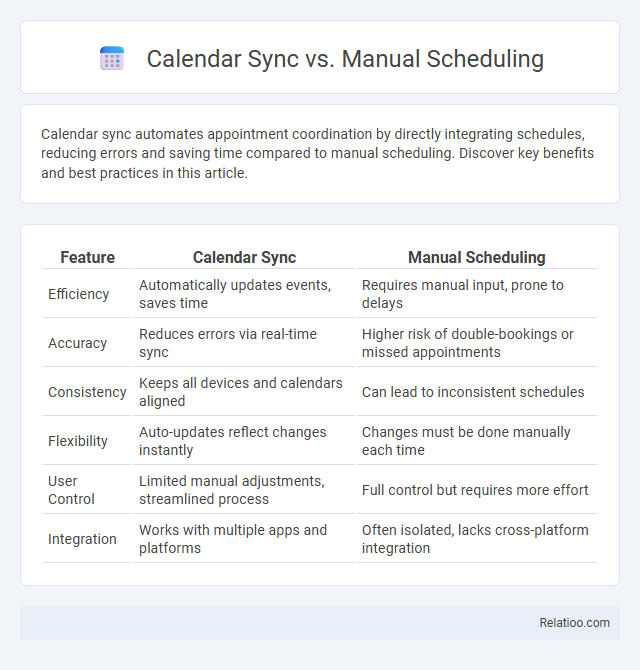Calendar sync automates appointment coordination by directly integrating schedules, reducing errors and saving time compared to manual scheduling. Discover key benefits and best practices in this article.
Table of Comparison
| Feature | Calendar Sync | Manual Scheduling |
|---|---|---|
| Efficiency | Automatically updates events, saves time | Requires manual input, prone to delays |
| Accuracy | Reduces errors via real-time sync | Higher risk of double-bookings or missed appointments |
| Consistency | Keeps all devices and calendars aligned | Can lead to inconsistent schedules |
| Flexibility | Auto-updates reflect changes instantly | Changes must be done manually each time |
| User Control | Limited manual adjustments, streamlined process | Full control but requires more effort |
| Integration | Works with multiple apps and platforms | Often isolated, lacks cross-platform integration |
Introduction to Calendar Sync and Manual Scheduling
Calendar sync automates the process of aligning appointments across multiple devices and platforms, ensuring real-time updates and reducing the risk of double bookings. Manual scheduling requires users to input events and adjust timings without automatic updates, increasing the chance of human error and conflicts. Synchronization improves overall efficiency by keeping calendars consistent, but calendar sync specifically streamlines this process through automated data exchange.
Key Differences Between Calendar Sync and Manual Scheduling
Calendar sync automates the process of updating and sharing appointments across multiple devices and platforms, ensuring real-time accuracy and reducing scheduling conflicts. Manual scheduling requires users to input and manage appointments individually, which increases the risk of errors and double bookings. Synchronization encompasses both methods but generally refers to the broader process of keeping data consistent across systems, with calendar sync providing a more efficient and seamless solution compared to manual efforts.
How Calendar Sync Works
Calendar sync automates the process of updating events and appointments by connecting digital calendars through APIs or synchronization protocols like CalDAV and Exchange ActiveSync. Manual scheduling requires users to individually enter or modify events, increasing the risk of errors and missed updates. Synchronization ensures consistency across multiple devices or platforms by continuously exchanging calendar data to reflect real-time changes instantly.
Pros and Cons of Calendar Sync
Calendar sync automates event updates across multiple devices, reducing scheduling conflicts and saving time by eliminating manual input errors. Its main advantage lies in real-time data consistency, enhancing productivity for users managing numerous appointments. However, calendar sync depends on reliable internet connectivity and may pose privacy risks if sensitive data is stored or shared without adequate security measures.
Manual Scheduling: Process and Challenges
Manual scheduling involves entering appointments or events into a calendar by hand, requiring careful attention to avoid overlapping or missed commitments. This process can be time-consuming and prone to human error, especially when managing multiple schedules or frequent changes. You may face challenges such as double bookings and lack of real-time updates, which can disrupt productivity and lead to miscommunication.
Advantages and Disadvantages of Manual Scheduling
Manual scheduling offers precise control over your calendar entries, allowing you to tailor appointments according to specific preferences and unique requirements. However, this approach is time-consuming and prone to human error, which can lead to double bookings or missed appointments. Unlike calendar sync or automatic synchronization, manual scheduling lacks real-time updates, making it less efficient for managing dynamic or high-volume schedules.
Comparing Efficiency: Calendar Sync vs Manual Scheduling
Calendar sync automates the process of updating appointments across multiple devices and platforms, significantly reducing the risk of double bookings and missed meetings. Manual scheduling requires constant attention to detail and increases the likelihood of human error, resulting in inefficient time management and potential scheduling conflicts. You benefit from calendar sync as it streamlines your workflow, saves time, and ensures your appointments stay consistently up to date without the need for repetitive manual input.
Best Use Cases for Calendar Sync
Calendar sync is ideal for professionals who need automatic updates across multiple devices and platforms, ensuring your schedule stays consistent without manual entry errors. This approach excels in settings with frequent changes, such as client meetings or team collaborations, where real-time updates improve efficiency and reduce scheduling conflicts. Manual scheduling is better suited for one-time or infrequent appointments, while synchronization is essential for integrating data across complex systems but may lack the immediacy needed for daily scheduling accuracy.
When to Choose Manual Scheduling Over Calendar Sync
Manual scheduling is ideal when handling complex or irregular appointments that require personalized adjustments and increased control over timing. It offers flexibility for last-minute changes, prevents automatic errors common in calendar sync processes, and ensures accuracy when syncing tools fail to address unique scheduling needs. Businesses with fluctuating meetings or specific time constraints benefit from manual scheduling instead of relying solely on automated calendar synchronization.
Conclusion: Which Scheduling Method Is Right for You?
Choosing the right scheduling method depends on your workflow efficiency and accuracy needs. Calendar sync automates event coordination by integrating multiple schedules in real-time, reducing conflicts and missed appointments. Manual scheduling offers control but can be time-consuming and prone to errors, while synchronization balances automation and customization for streamlined planning that fits your specific demands.

Infographic: Calendar Sync vs Manual Scheduling
 relatioo.com
relatioo.com